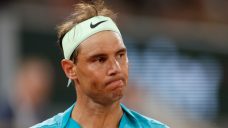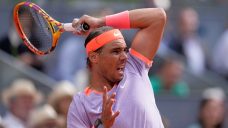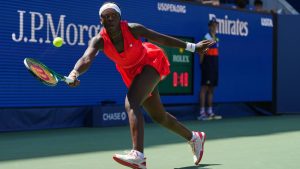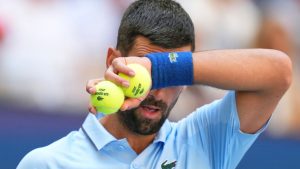'If it didn’t end badly, it wouldn’t end' is a quote that rings true for many athletes. In the case of one Rafael Nadal, good, bad, or ugly, it won’t end until it ends.
He’s a man who never knows when he’s beat. When deemed a clay court specialist, he won the hard-court slams (Australian Open, U.S. Open) a combined six times and Wimbledon twice. He’s battled through injuries to play for, in some prognosticator’s estimations, seven to eight years longer than he should have due to the physical nature of his game.
The slightest inkling of feeling good about himself and his game is enough to push on for another year or more, as the most recent practices showed despite the unfamiliar results on his favourite surface. So, now, after publicly announcing a little over a year ago his intention that 2024 would be his final year, the idea of finality is once again something he’s not willing to accept.
“Don’t assume that,” Nadal said when asked if this will indeed be his last French Open. “In terms of whether it’s going to be my last Roland Garros, it’s a long answer but I think I need to answer that so we can avoid future questions. It’s a big, big chance it’s gonna be my last Roland Garros, but if I have to tell you it’s 100 per cent gonna be my last Roland Garros, sorry but I will not. I’m not a guy who reacts because I lost here or lost there. My personal feelings are better now than one-month-and-a-half ago, without a doubt.
“I don’t want to 100 per cent close the door because of very simple things. First thing, I am enjoying playing tennis, second thing: I am travelling with the family and enjoying this process with them. Third thing: I was not able to explore yet the proper way to play being in more or less healthy condition and playing without limitation.”
Reality is staring us in the face after a 6-3, 7-6(5), 6-3 loss to Alexander Zverev in the first round of this year’s French Open, but the romance of believing in Nadal when he’s played this year and for however long he continues to play is a testament to who he is.
When asked by different people about how I rated Nadal’s chances of winning the French Open as he continued to struggle in his return from injury, nothing could bring me to remove him from contender status.
Not a straight-sets loss in the second round to 11th-ranked Alex de Minaur in Barcelona, where he has held the trophy aloft 12 times; not a fourth-round straight-sets loss to 23rd-ranked Jiri Lehecka in Madrid, where he has won five times; nor a second-round straight-sets loss to eighth-ranked Hubert Hurkacz most recently in Rome, where he has claimed the title 10 times.
Nadal, it must be said, has largely looked very un-Rafa-like. His body seems unwilling to do what his mind wants, and save for a few flashes and stretches, he’s looked a shadow of the man who has his statue already erected at Roland Garros. Yet I couldn’t erase the memory of who Nadal has been at the event in favour of the player he looks now.
Respect is earned, not given, and this is simply what Nadal has earned.
Watching him bite into the Musketeers’ cup 14 times has warped any sense of reality. People probably stopped asking if Cal Ripken Jr. could be durable after 1,000 consecutive games played, let alone the record 2,632 he got to. No one wondered if Michael Phelps could win another Olympic gold after returning from retirement with 18 Olympic golds already to his name. Even as Serena Williams faded into the sunset, people saw the staggering list of accomplishments and knew she was always a threat to win a tournament as long as she held a racquet. She ultimately went her final 15 Slams without a title but was on the brink of one on several occasions.
So, rule out the man who has won a single Grand Slam event as many times as Pete Sampras has total Grand Slam titles? This man may be ranked 276th in the world currently, but he was also 112-3 at the French Open coming in. In a career that has spanned over two decades, only two players have ever beaten him here: Robin Soderling (2009) and Novak Djokovic (2015, 2021). Zverev has now joined exclusive company.
Three words are synonymous with Nadal at the French Open: dominant, favourite, champion. In 18 Roland Garros appearances, he’s never lost a final, he’s only lost a semifinal once, and a quarterfinal just once as well. Legend Bjorn Borg won the French Open six times and that was considered a humongous total at the time, an all the more impressive feat when considering he retired from the sport at just 26 years of age. As astonishing as winning six out of seven French Open titles in a stretch is, Nadal outdid the Swede by winning nine out of 10 by the age of 28.
The current World No. 1 and all-time total Grand Slams leader Djokovic could win the 2024 title, become the all-time third-leading men’s French Open winner, and still be a cool 10 titles away from Nadal.
Roger Federer looked far and away the greatest player of all-time at one point and finished with a solitary title at Roland Garros because of Nadal. The Spaniard went a perfect 6-0 against Federer at this tournament (4-0 in finals) including one of the most humiliating losses of the Swiss maestro’s career: 6-1, 6-3, 6-0 in the 2008 final. Nadal won 18 of the 22 sets they played. The overall head-to-head stands 24-16 in favour of Nadal, and it further illustrates just how much more difficult Nadal is on clay, where the Spaniard holds a 14-2 edge in the matchup on the surface.
Nadal finished 8-2 against Djokovic at this event, the Spaniard winning a bit less lopsided 24 of the 35 sets played. So, that’s a combined 14-2 against his two greatest rivals at this event including 42 of 57 sets won. On clay in general, Nadal leads 20-8 against Djokovic in an overall head-to-head that reads 30-29 to the Serb. You could quite literally assemble the Avengers of tennis to take on the Thanos of Roland Garros and it would end quite miserably.
What makes Nadal such an impossible proposition on the surface is the absolutely ridiculous amount of top spin he generates on his shots that goes into overdrive on clay. Rally shots that regular opponents hit may be at or around waist height whereas, with Nadal, those shots are having to be returned from shoulder height and even above. Throw in that, as a lefty, Nadal’s crosscourt forehand generally goes across to a right-hander’s backhand — something that was a primary source of Federer’s problems in the matchup — and it wreaks havoc with creating a winning strategy.
Nadal’s patented lasso whip style forehands have an average RPM (revolutions per minute) of 3,200, but he has been clocked over 5,000. What that does is cause the ball to rise much higher off the surface and thereby create much less margin for error for his opponent. The only time Nadal didn’t generate as much bounce as he’s accustomed to was in 2020, when the tournament was played in chilly October instead of balmy late May and early June.
Then there’s the relative slowness of the court compared to grass or hard courts that makes his defence all the more impenetrable. Nadal has the heart of a lion, and when players get asked to pick an assortment of shots and traits they’d like to have belonging to the greatest players of all-time, Nadal’s fighting spirit and intensity is a default choice. It’s what has made him a fan favourite over the years and has him chasing down every ball in sight.
Just thinking of all those long rallies followed by an emotional fist pump can leave you with adrenaline for days. Scrambling one way and then the other, the opponent thinking he’s put himself in an advantageous position, and then that vintage banana forehand unleashed down the line or cross court to leave the opponent with nothing to do but sigh and shake their head.
Nadal played well against Zverev, but it just looked too soon to face a player of the German’s calibre in excellent form. Nadal huffed and puffed, his breaks of serve sending the crowd and those of us watching at home into delirium, but there just wasn’t enough to give for long enough.
There is nothing owed to anyone but himself. When Nadal battled a back injury, a wrist injury, and spent time out due to appendicitis as well in 2014, it was entirely plausible the end was near and he’d finish a 14-time Grand Slam champion. After a barren stretch of 11 Slams without a title (two where he didn’t even participate and not a single semifinal appearance), Nadal found magic again in 2017 to play an all-time final against Federer at the Australian Open before reclaiming the French Open. Then, he improbably won another eight Slams, including four at Roland Garros.
And that’s why, for all that has been said and all that we’ve seen in 2024, if he ever enters the French Open again, I’ll back him. There are certain people who you’ll go down with the ship for, and Nadal is one of them. This ship is sinking, you can see the leaks, the water breaking through, but this captain has righted the ship so many times that if this is how it goes down, so be it.
Nadal’s comments prior to his match against Zverev suggested he wants to leave the game feeling healthy, not feeling like this version of himself. He wants to say goodbye to the athlete he’s known and seems desperate to dig as deep as possible to find that peace. Djokovic recently said a part of him will be gone whenever it is Nadal goes. It feels the same for anyone who’s consumed tennis over the past two decades, just as it was when Federer emotionally bid farewell at the Laver Cup.
This is how it will end, everyone seemingly knowing what's in front of them in the here and now but not wanting to lose what they’ve seen for so long, no one more than himself. In Nadal’s movie, you expect a post-credits scene that just never ends. In Nadal’s movie, you’d never expect to see ‘The End.’






